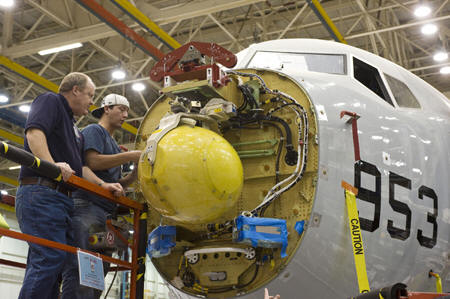
NEWSROOM
 |
NEWSROOM |
|
|
|
|
|||
|
Radar Antenna
Installed On Boeing P-8A Poseidon By Daniel Baxter |
||||
 |
December 2, 2009 - A Boeing and a Raytheon employee complete
installation of an APY-10 radar antenna on P-8A Poseidon test aircraft
T2 last month at the Boeing Developmental Center in T2 is the P-8A program's primary mission system test article. Following completion of the next phase of radar installation and additional instrumentation, T2 will enter the U.S. Navy's flight test program in early 2010. During flight test, Navy and Boeing pilots will verify the performance of all aircraft sensors.
The P-8A radar antenna was developed and delivered by Raytheon. Boeing's
industry team is building and testing five anti-submarine warfare,
anti-surface warfare, intelligence, surveillance and reconnaissance
aircraft as part of a System Development and Demonstration contract
awarded in 2004. |
|||
|
The P-8A Poseidon
is a long-range anti-submarine warfare, anti-surface warfare,
intelligence, surveillance and reconnaissance aircraft capable of
broad-area, maritime and littoral operations. A derivative of the
Next-Generation 737-800, the P-8A combines superior performance and
reliability with an advanced mission system that ensures maximum
interoperability in the future battle space.
Customers:
The P-8A is being developed for the U.S. Navy by a Boeing-led industry
team that consists of CFM International, Northrop Grumman, Raytheon, GE
Aviation and Spirit AeroSystems.
The U.S. Navy plans to purchase 108 P-8As to replace its fleet of P-3C
aircraft. The first aircraft will begin formal flight test in 2009 and
initial operational capability is slated for 2013.
On Jan. 1, 2009 Boeing signed a contract with the Government of India to provide eight P-8I long-range maritime reconnaissance and anti-submarine warfare aircraft to the Indian navy. The P-8I is a derivative of the P-8A designed specifically for the Indian navy. |
||||
|
General
Characteristics:
Propulsion: Two CFM56-7 engines providing 27,000 pounds thrust each
On April 27, 2009 -- Boeing
P-8A Poseidon test aircraft T-1 successfully completed its first flight
April 25, taking off from Renton Field at 10:43 a.m. and touching down
at Boeing Field in Seattle at 2:14 p.m. The P-8A performed a series of
flight checks, reached a maximum altitude of 25,000 feet, and landed
after three hours, 31 minutes in the air.
"This is a significant accomplishment for the P-8A team, as it moves us
one step closer to delivering the next maritime patrol and
reconnaissance aircraft to the warfighter," said Capt. Mike Moran, P-8A
program manager for the U.S. Navy. "Today's flight is a clear
demonstration of the program's commitment to delivering this critical
capability on time and the result of a tremendous effort by the joint
Navy/Boeing team. I commend Boeing for putting its 'A-Team' in place on
this program and enabling the Navy to leverage Boeing's experience,
expertise and, more importantly, dedication to make this aircraft a
reality."
Prior to takeoff, the P-8A team completed a limited series of flight
checks, including engine starts and shutdowns. During the flight, test
pilots performed airborne systems checks including engine accelerations
and decelerations, autopilot flight modes, and auxiliary power unit
shutdowns and starts.
"This is an exciting day for the P-8A program and a tribute to the hard
work of the entire team," said Bob Feldmann, Boeing vice president and
P-8 program manager. "We understand the needs of the U.S. Navy and
maritime patrol community, and we are dedicated to meeting every one of
our future milestones on or ahead of plan."
The integrated Navy/Boeing team will begin formal flight testing of the
P-8A during the third quarter of this year. Before that, Boeing will
paint the aircraft, install additional flight test instrumentation and
conduct a series of ground tests.
The P-8A, a derivative of the Next-Generation 737-800, is built by a
Boeing-led industry team that includes CFM International, Northrop
Grumman, Raytheon, Spirit AeroSystems and GE Aviation. The team
currently is assembling and testing the first five P-8As.
The Navy plans to purchase 108 P-8As to replace its fleet of P-3C aircraft. Initial operational capability is planned for 2013. |
| ?AvStop Online Magazine Contact Us Return To News |
|